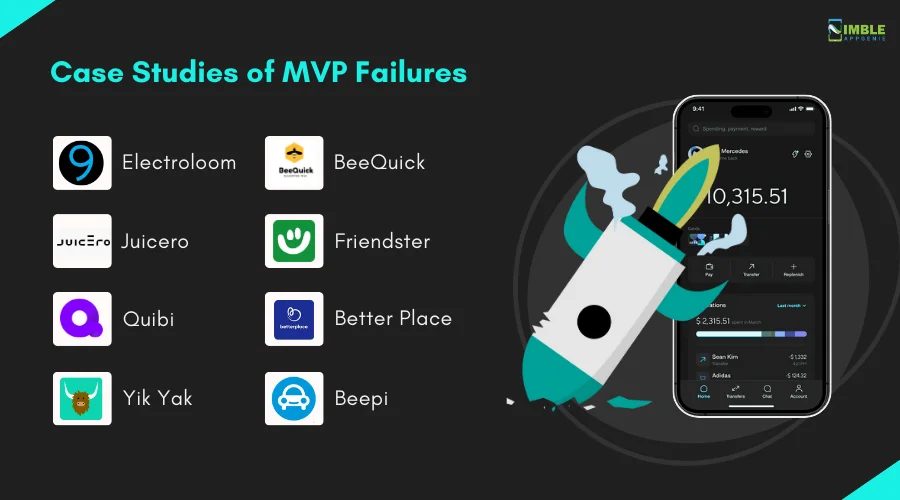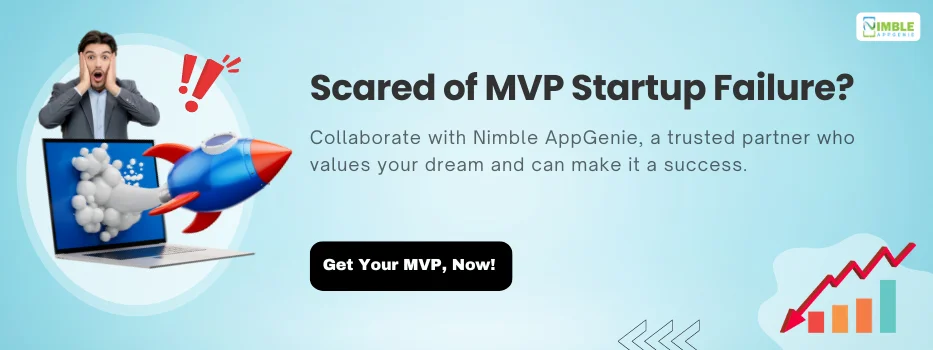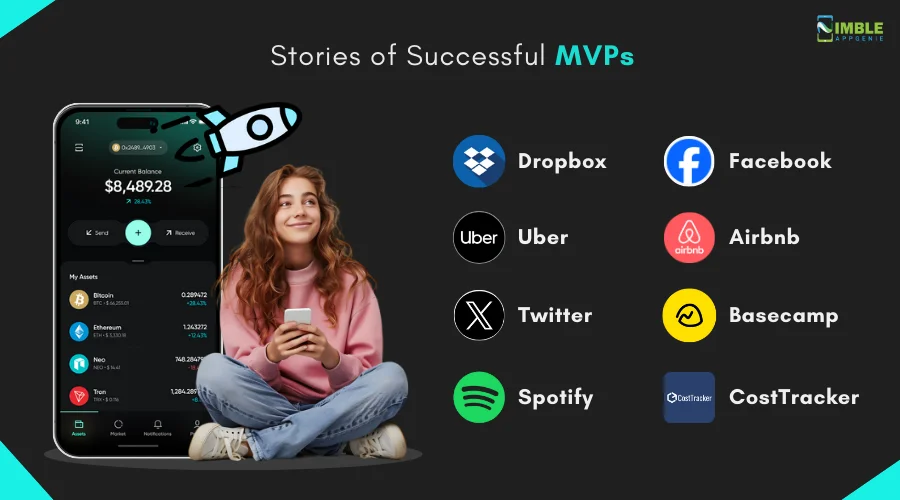Want to build an MVP?
Minimal Viable Product (MVP) can be defined as a trial app that comes with basic functions developed to target early adopters and to know the ground reality of its working.
Have you seen MVP fail?
Relax, we are not here to scare you but rather to understand the reason behind MVP development.
Well, if you directly go to build an app, that can be a huge risk. Therefore, investing in an MVP can help. Yes, MVP can also have a probability of failing.
However, it can cost you a little to lose.
If you want to know why MVPs fail, then it’s the right place to learn.
Here we will start by discussing the real case studies of MVPs, and analyze the common reasons that made them fail.
Later we will discuss certain success stories and end up learning important tips helpful to avoid MVP failure.
Shall we begin the journey?
Case Studies of MVP Failures
Are you interested to know about the MVPs that failed?
Here are some of the case studies you should learn.

1. Electroloom
Electroloom was started to process raw materials to finished goods directly. They developed the world’s first 3D printer and used it to create and design ready-to-wear garments. With the help of a radical device, they were able to create a garment with the help of electrospinning. However, this MVP failed.
Reasons for Failure:
- Poor User Experience
- Improper Market Analysis
- Unawareness about the right usage of technology
- Improper Resource management
2. BeeQuick
BeeQuick was one of the MVPs that failed. It was a Chinese startup that wished to revolutionize the grocery delivery sector of China. The company spent too much money on the logistic network substantially increasing its operation expenses and running out of cash.
Reasons for Failure:
- Unable to deliver a good customer experience
- Mismanagement of Finance
- Struggles to gather a wide range of users
- Poor Planning
3. Juicero
Juicero was an MVP that launched to bring revolution in the health and wellness industry. They have their product as a Wi-Fi-connected juicing machine which is used to press proprietary, pre-packaged fruit and vegetables into fresh juice. It failed due to many reasons.
Reasons for Failure:
- Lack of Capital Management
- Extreme expensive product
- The flaw in the product’s value proposition
- Lead to poor customer experience
4. Friendster
Friendster was launched as an MVPs and became famous as a social networking and gaming site. On this platform, users create profiles to connect with friends. It is the social media startup that failed and closed in the year 2015. The platform had 8.2 million users in 2010 but failed due to certain reasons.
Reasons for Failure:
- Poor Website Performance
- Strict Content Regulation Practice
- Highly Competitive Social Media Industry
- Scalability issues
 5. Quibi
5. Quibi
Quibi was founded in 2018, August as a short-form streaming platform whose aim was to generate content. This content can be watched on mobile devices. The MVPs targeted younger demographics where the content gets delivered in 10-minute episodes termed quick-bites.
Reasons for Failure:
- Failed to Integrate Essential Features
- Unable to Identify Potential Users
- Poor Quality Content
- Unjustified Price
6. Better Place
Better Place was an MVPs that developed to sold battery charging and battery switching devices for electric cars. Although, in the end, the company failed. They even tried to sell it but nothing worked. Later they put it into liquidation proceedings.
Reasons For Failure:
- Mismanagement of Finance
- Unable to understand their niche market
- Lack of effective technology usage
- Battery Swapping was a challenge
7. Yik Yak
Yik Yak was a social media smartphone application that was launched in 2013. The platform targeted school and college-going youths by providing them the platform to get engaged and to share documents anonymously. However, the MVPs became the target of cyberbullying.
Reasons For Failure:
- Became an Insecure Platform
- Noted the incidents of cyberbullying
- Society imposed strict regulations to ban the app
- Anymousness became a threat
8. Beepi
Beepi was an online peer-to-peer marketplace for user cars. The platform also promised to make the transactions safe, easy, and profitable for all the involved parties. It was an MVP that made it easy for car buyers and sellers to buy and sell used cars at affordable prices.
Reasons For Failure:
- Mismanagement of Budget
- Had a high burn rate
- Logistic challenges
- Unable to retain potential customers
Studying the case studies of the MVPs might have gone clear about the reasons that made them out of the market.
Well, here we have simplified it for you by availing a simple list that delivers reasons led MVPs to fail.
Common Reasons that Led MVPs Fail
Apart from learning the case studies of MVP failed it is significant for you to know the common mistakes to avoid building an MVP.
Are you willing to learn them all? Here is the list of common reasons that result in MVP failure.

► Not Understanding the Target Audience
Underestimating the needs of the target audience and avoiding understanding them completely can be your biggest mistake. Before you launch an MVP, it is important to determine the type of target audience. Failing to do it can lose your MVP and the cost invested in it.
► Lack of Market Research
Before you proceed with the MVP, it is important to know its current value in the market. Conducting effective market research can help you here. If you fail to collect enough data based on the market demand then it can end up your dream app just after building an MVP.
► Unclear Goal
One of the prominent reasons that led MVPs to fail is the clearance of the goal. If you are not clear about what you want to achieve then it’s better to give up on MVP development. You need to make a final aim that can motivate to draft a whole plan for making an investment in mobile apps.
► Poor Technical Implementation
MVP development can be beneficial only if you know the use of the right tech stack. Possession of an ineffective database or prescribed computer language can result in MVP failure. With the wrong technology selection, the needs of users are kept unmet.
► Insufficient Testing
Although it’s an MVP, you cannot launch it with enthusiasm. It is important to take time to test it. If you test MVP, the growth of your app’s success can strengthen. Avoiding the testing process of MVP can result in maximizing errors which can make it hard for early adopters to use it.
► Avoiding Marketing
After the launch of MVP, it is after performing mobile app marketing. Avoiding it can end your app with no users as you will be unable to reach the target audience. Yes, marketing can take your cost, but ignoring it can lose your capital.
► Incorrect Budget Management
Improper management of the budget can be a significant point to remember. If you avoid the management of the budget, it can leave you with an increase in cost to build an MVP. Which will ultimately lead to you losing the MVP.
► Inappropriate User Experience
If you avoid UI/UX design just because it’s an MVP you think that it is a trial package of what you want to serve the audience. Inappropriate user experience will not only result in losing users but also can destroy the image of the brand in its initial phase.
Stories of Successful MVPs
Now, we have covered what not to do while creating an MVP. What about learning the points that you should consider during MVP development?
Before we discuss the tips, you should know the stories of successful MVPs along with the reasons for their success. Here you go.

1] Dropbox
What has made Dropbox a success?
Well, the secret relies on its MVP development. After its MVP development was a success, adding missing features and maintaining it was all they left with. Out-of-the-box ideas and the ability to engage a larger audience are some of the prominent steps that make it succeed.
Reasons for Success:
- Simple and Clear concept
- Provides extreme security to users
- User-centric model of application
- Engaging and simple user interface
2] Facebook
Who thought Facebook would capture the interest of millions of people one day?
With over three billion monthly active users as of 2024, the platform has succeeded in bringing a revolution in the social media industry. Its MVP development was all its secret that made it one of the most popular apps.
Reasons for Success:
- A diverse user interface
- Effective Monetization model
- Engaging News Feed
- Helps to build social connections
3] Uber
Have you tried an Uber taxi at least once?
Uber launched its MVP and started with only three cars to be used as a taxi. They kept the interface of the app simple and only launched it in one city. The brand was accepted by the early adopters. It became a reliable, cheap, and convenient service that offers a tech-driven user interface.
Reasons for Success:
- User-friendly software
- Keeping customers promises
- Affordable prices
- Understands its user segment so well
4] Airbnb
Short stays and accommodations are just like home, that’s what Airbnb is up to.
Airbnb is an American company that operates in an online marketplace for short and long-term homestays. This platform has provided a connection among people who are looking for short-term accommodations.
Reasons for Success:
- User-centric approach
- Use of the latest technology
- Diversification and innovation
- Understanding the target audience demands
5] Twitter
Did you use Twitter (X)?
Twitter was started as an MVP and was started as an idea to build an SMS service. The platform helped a group of people to communicate and became one of the largest networks. It became an instant hit and formed its world-class reputation.
Reasons for Success:
- Conducted market analysis
- Innovative app idea
- Effective app features
- Connected diversified audience
Bonus Read: Cost to Build an App Like Twitter(X)
6] Basecamp
A platform with which professionals like to work.
Basecamp was an app that was formed due to the need for a design firm. The team found it frustrating to deal with the problems that are faced during managing projects via email. That’s where the MVP was created. Within this app, users can find a message board to have updates and feedback, along with to-do lists and milestones at work.
Reasons for Success:
- Straightforward collection of data
- Centralized communication so that no thread or task got missed
- Keeps feedback and revisions on record
- Track work progress
7] Spotify
Do you like to stream music over Spotify?
Spotify started with the basic landing page which offered a streaming music feature. This platform launched after repeatedly testing their product. They preferred to use agile methodology which makes it an engaging platform with scalable features.
Reasons for Success:
- Clear goals and objectives
- User-centric model
- Knows how to engage users
- Effective streaming feature
8] CostTracker
You can use CostTracker to save your cost and time.
CostTracker is one of the amazing cloud-based software that helps companies save cost and time by subsequently streamlining workflow and communication. This platform assists the users in tracking costs and helps you understand where and how your projects fit within the budget.
Reasons for Success:
- Able to read users’ demands
- Helps to track costs for businesses
- Well designed budget
- Effective features
Are you prepared to start with MVP, now?
With the case studies of successful and failed MVPs, we provided you with a list of dos and don’ts. If you want to have more tips for developing a successful MVP, then you can follow the given tips in the next section.
Effective Tips to Develop Successful MVP
Still confused about how to proceed?
The given list of tips for developing a successful MVP can help you here.

-
Conduct Proper Market Research
You should conduct proper market research before proceeding with MVP. With the help of market research, you will be able to draw users’ personas. It will end up finding the actual app users with the ability to connect them prominently.
-
Prioritizing User Engagement
Prioritizing user engagement is one way to build a successful MVP. Here you should know your end users well to engage them. If possible, you can conduct a survey to connect with potential app users, it can help you to add features that will make them engage with the app.
-
Choose the Right Technology
Selecting the right tech stack is the medium that makes MVP succeed. You only need to select the technologies that align intending to build it. Market research can help you in this scenario, where it is required to cover all the technical and non-technical needs of your app.
-
Implement Testing Process
Testing can help you avoid bugs and errors that in the future may result in enhancing the overall performance of the app. Rigorous testing is one of the key steps which can be used to prevent errors. You can implement different types of testing where you can save time and resources.
-
Set a Defined Budget
Budget plays a vital role in ensuring the growth of your MVP. Here you should decide on the development cost, design expenses, market research, marketing promotion as well as operational costs. It can also help you to allocate resources effectively.
-
Select Core Features
MVP development requires you to select basic and advanced features. Here you need to prioritize your core requirement of the users. This is the point where you can build up a list of the core features essential for making the app.
-
Make a Simple Design Interface
If you think a design with complex features may work to gain users’ attention, well it won’t. Users need that they can operate the app simply without even bothering much. A complex design only makes them confused over navigating through the app.
-
Develop a Feedback Loop
Developing an MVP will not work well until you allow early adopters to provide feedback after using the app. Here you can develop a mechanism that is effective to collect potential feedback from the app users.
Willing to start with an MVP?
Well, selecting a team to trust should be your next step now.
How Can Nimble AppGenie Help to Make an MVP?
Till now, you learned the lessons from MVPs’ failures and success stories. Along with the points that you should implement and vice versa.
Well, MVP cannot be developed without a team.
Connect with Nimble AppGenie, an effective MVP app development company that is able to work on your opinions and demands.
We have a panel of experts dedicated to making your MVP a success.
Conclusion
MVP development is not rocket science until you know what can be the measures that can’t make it a success. With the case studies of MVPs like Yik Yak, Better Place, and Beepi, you should learn points that have made them a failure.
However, from MVPs like Facebook, Spotify, and Airbnb, you can learn what should be attempted to achieve success. Apart from this, there are certain tips to implement including adopting marketing research, selecting core features, prioritizing the user’s engagement, etc. Working with an experienced company is key to achieving success like top MVP apps.
FAQs
MVPs can fail for various reasons, including:
- Poor user experience
- Inadequate market research
- Mismanagement of finances
- Failure to identify and understand the target audience
- Lack of clear goals
- Insufficient testing
- Ineffective marketing strategies
A Minimum Viable Product (MVP) is a basic version of a product that includes only the essential features needed to solve a core problem for early adopters. The goal is to test the product idea and gather feedback from real users to guide further development.
Yes, some examples include:
- Electroloom: Failed due to poor user experience and improper market analysis.
- BeeQuick: Failed due to high operational expenses and mismanagement of finances.
- Juicero: Failed because of an expensive product and poor value proposition.
- Friendster: Failed due to poor website performance and scalability issues.
- Quibi: Failed due to poor quality content and an unjustified price point.
- Better Place: Failed because of financial mismanagement and challenges with battery swapping technology.
Building an MVP helps mitigate risk by allowing you to:
- Validate your product idea with real users.
- Gather essential user feedback to guide development.
- Test the market demand before committing to a full-scale product.
- Save time and resources by focusing on core features initially.
Common reasons include:
- Not understanding the target audience.
- Lack of thorough market research.
- Unclear goals and objectives.
- Poor technical implementation.
- Insufficient testing.
- Ineffective budget management.
- Poor user experience.
- Inadequate marketing efforts.
To increase the likelihood of your MVP’s success:
- Conduct thorough market research to understand your target audience and competition.
- Define clear, measurable objectives.
- Prioritize user engagement and gather continuous feedback.
- Choose the right technology stack and implement rigorous testing.
- Manage your budget effectively and plan for marketing expenses.
- Focus on delivering a simple, intuitive user experience.
- Develop a feedback loop to refine and improve the product based on user insights.

Niketan Sharma is the CTO of Nimble AppGenie, a prominent website and mobile app development company in the USA that is delivering excellence with a commitment to boosting business growth & maximizing customer satisfaction. He is a highly motivated individual who helps SMEs and startups grow in this dynamic market with the latest technology and innovation.
Table of Contents





No Comments
Comments are closed.